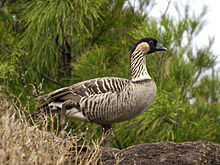Hawaiian goose
| Nene | |
|---|---|
 |
|
| At Kilauea Point National Wildlife Refuge, Hawaii, USA | |
| Scientific classification | |
| Kingdom: | Animalia |
| Phylum: | Chordata |
| Class: | Aves |
| Order: | Anseriformes |
| Family: | Anatidae |
| Subfamily: | Anserinae |
| Tribe: | Anserini |
| Genus: | Branta |
| Species: | B. sandvicensis |
| Binomial name | |
|
Branta sandvicensis (Vigors, 1833) |
|
The nene (Branta sandvicensis), also known as nēnē and Hawaiian goose, is a species of goose endemic to the Hawaiian Islands. The official bird of the state of Hawaiʻi, the nene is exclusively found in the wild on the islands of Oahu,Maui, Kauaʻi, Molokai, and Hawaiʻi.
The Hawaiian name nēnē comes from its soft call. The specific name sandvicensis refers to the Sandwich Islands, an old name for the Hawaiian Islands.
It is thought that the nene evolved from the Canada goose (Branta canadensis), which most likely arrived on the Hawaiian islands about 500,000 years ago, shortly after the island of Hawaiʻi was formed. This ancestor is the progenitor of the nene as well as the prehistoric Giant Hawaiʻi goose and nēnē-nui (Branta hylobadistes). The nēnē-nui was larger than the nene, varied from flightless to flighted depending on the individual, and inhabited the island of Maui. Similar fossil geese found on Oʻahu and Kauaʻi may be of the same species. The Giant Hawaiʻi goose was restricted to the island of Hawaiʻi and measured 1.2 m (3.9 ft) in length with a mass of 8.6 kg (19 lb), making it more than four times larger than the nene. It is believed that the herbivorous Giant Hawaiʻi goose occupied the same ecological niche as the goose-like ducks known as moa-nalo, which were not present on the Big Island. Based on found in fossils, all Hawaiian geese, living and dead, are closely related to the giant Canada goose (B. c. maxima) and dusky Canada goose (B. c. occidentalis).
...
Wikipedia

